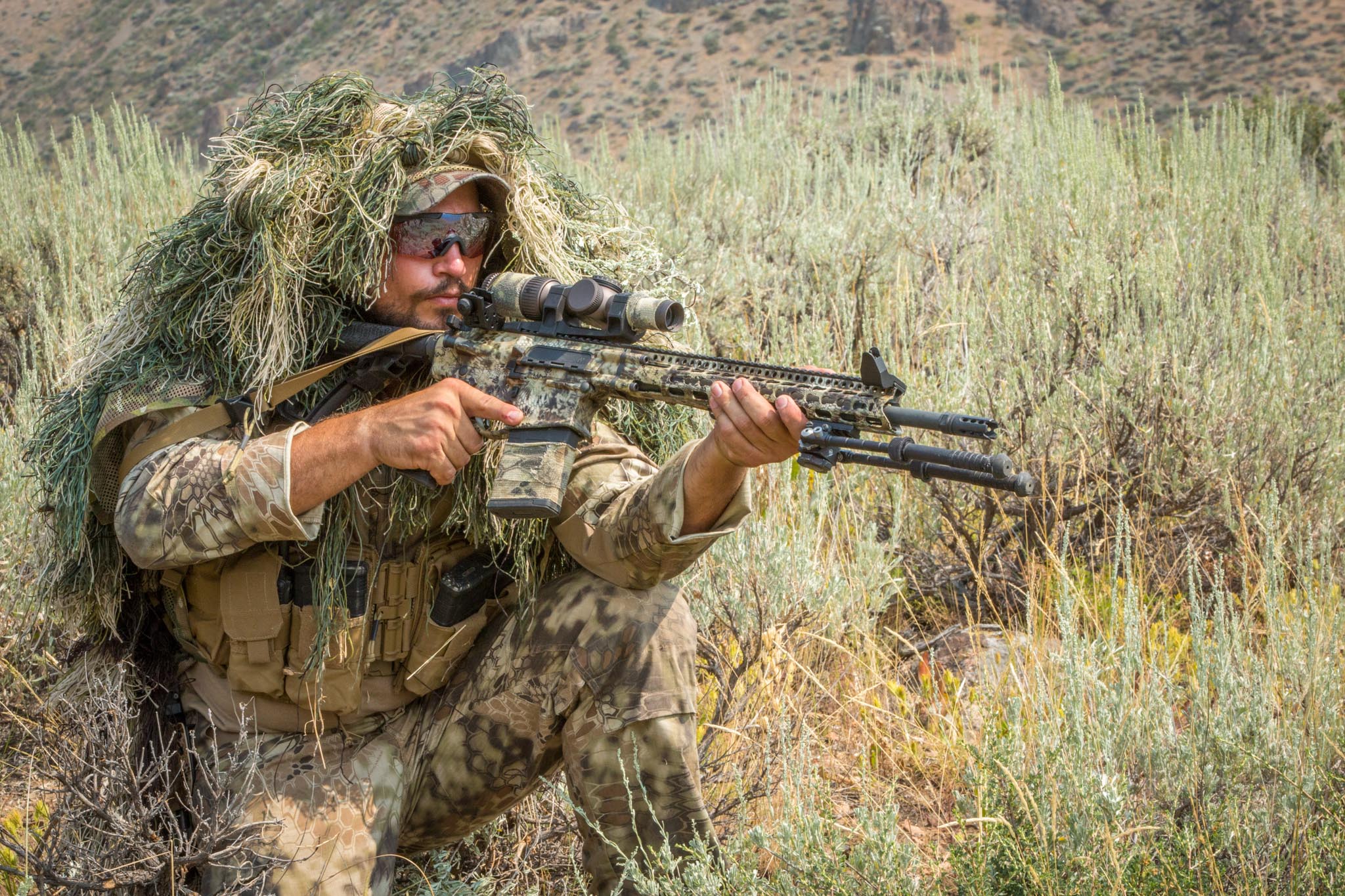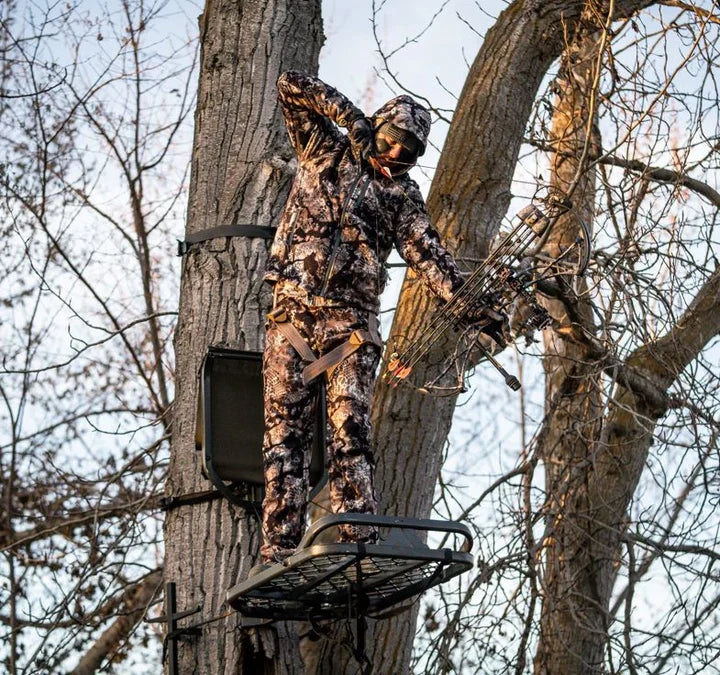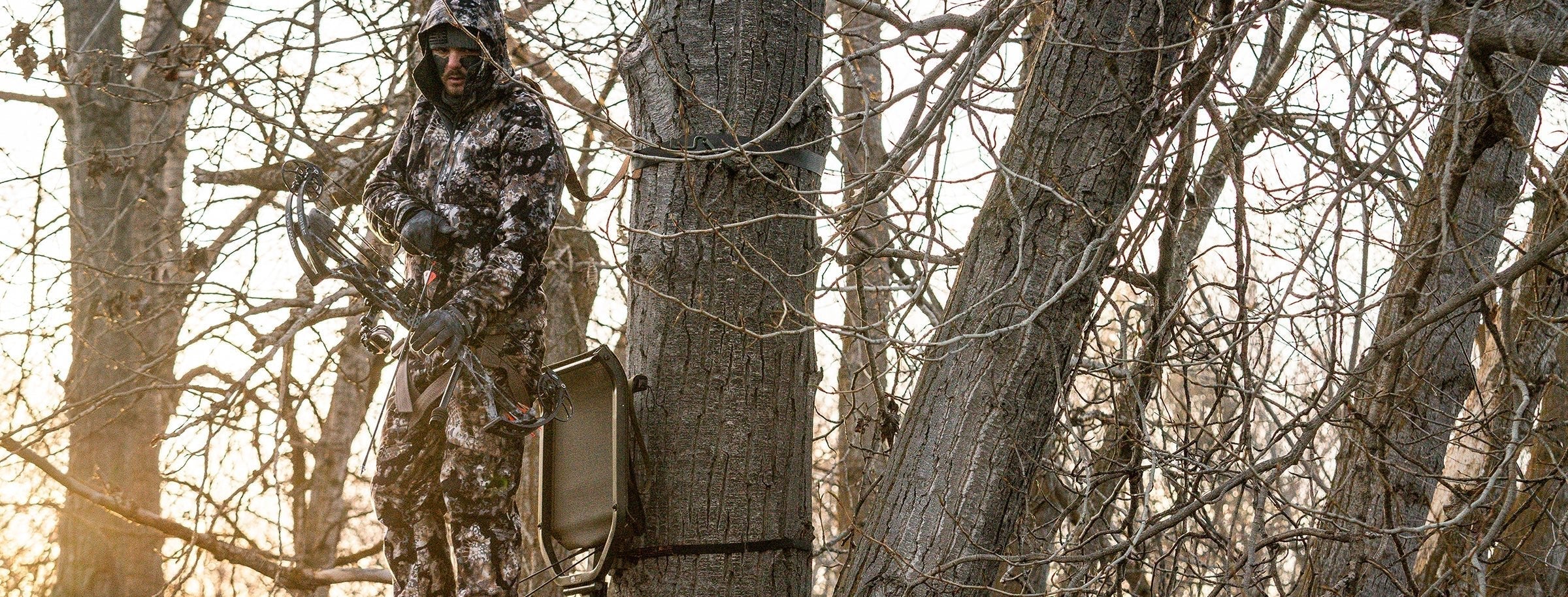
The Pinnacle
The Pinnacle
02/09/2023
Story and Photos by: Janna Waller
SLIDING THE RIFLE OFF MY SHOULDER, I POPPED THE BIPODS OUT AND SET HER DOWN IN THE SNOW.
It was nearing the end of a long, exhaustive day and my energy was dwindling. I walked over to the edge of the saddle to peer into the icy canyon on the backside. My legs were sore and my face felt the sting of the cold wind. Heath, my cameraman and hunting partner, was going to stay put, keeping an eye on the snowy hillside above us. The sun would soon be setting and the temperature, along with my odds, were slowly dipping. Suddenly, Health whistled! I whipped around and looked up on the ridge. There, a mere 140 yards away, stood a beautiful, bighorn ram, staring down at me as if straight out of a dream. His flared horns and broad chest made him look like a proud King of the mountain. Here was the moment I’d been praying for! 15 days of hunting, hiking and hard work coming to fruition… and I was thirty yards away from my gun!

I was on a Rocky Mountain Bighorn sheep hunt in Montana. The kind of adventure most big game hunters fantasize about. Myself included. I couldn’t believe it was happening. I remember the exact moment I looked down at my phone and read the word, "SUCCESSFUL," next to the sheep category. I happened to be with Heath that day too. We were heading to Idaho to refresh our bear baits when he pulled into the gas station to fill up.
“Hey, draw results are out today. Did you check?” he asked, before walking in to grab some drinks. He appeared minutes later to the sound of me screaming from the truck. “Heath! Heath! Come look at this! Am I reading this right?!” He let out an expletive or two and confirmed I wasn’t hallucinating! Thanks to Robert Hanneman of Huntin' Fool, who helped me decide where to put in for tags, I was going on a Montana Bighorn Ram hunt in my very own backyard! Well, an hour-and-a-half away, really, but still… backyard enough.

The tools we have as hunters today would mystify our ancestors. My scouting started out with such a tool, the OnX maps new 3D layer. I had never used it before this scouting mission and it was literally like flying overhead and exploring the terrain from above. Mid-summer I started looking through the unit on my laptop, scouring the ridges and timber, looking for good ways to access certain canyons. After gathering intel from friends who’ve hunted the unit, I knew where I would focus my time come the November rut, but I wanted to explore some other options for the early start of my hunt in October.

My friends and I spent a few days late August hiking into some prospective canyons in hopes of spotting sheep or seeing signs. Although we didn’t find any bighorns on our excursions, any time in the Montana backcountry is always a treat. I was trying to figure out if a pack-in trip was worth the energy and time. Since I don’t have horses or mules, a backcountry tent-style hunt is a lot of work as well as a gamble if the sheep aren’t in that area. The August scouting hikes helped me eliminate a few drainages from the list if nothing else. And when you’re filming a hunt, there’s a lot of things to consider in terms of planning. This hunt was going to be filmed for my CarbonTV series ‘Skull Bound Chronicles'. Packing camera gear, extra lenses, batteries, chargers, etc. all needs to be considered when trying to decide where to go and how to get there. Heath and I decided we were going to start the hunt in mid-October and have a base camp right inside the unit to maximize our time.

My fiancé John, a Utah native, was able to come to Montana and join Heath and I for the first 4 days of the hunt. We towed our camper down to the unit and set up shop near a beautiful creek. The weather was more like January than October with the snow and frigid temps, so the camper was a great call.

October 11th was the first day of the actual hunt, where we stood high above a well-known landmark called Painted Rocks Reservoir. Named for its orange and mustard colored cliff faces, the granite peaks surrounding the water make for a spectacular backdrop when glassing for sheep and other Montana wildlife. This area holds almost every big game species of the West including healthy populations of black bears, mountain lions, wolves, elk, muleys, whitetails, sheep and mountain goats. Sparse snowflakes were flying and the air stung our cheeks, but there were big smiles on all threee of our faces.
Heath and I were interrupted while filming a quick intro about the excitement of opening morning when John lifted his head from the spotter and said, “I’ve got sheep.” Just 10 minutes into glassing the opposing side of the lake, we counted seven ewes munching on grass in an opening of the thick timber roughly 1,000 yards away. It was so thrilling finding a nice group so quickly despite it being just ewes. But, if we could find and keep track of the ladies, we should be able to easily find some big boys come November when love is in the air and the sheep rut starts to kick in.
After combing apart the landscape with our Vortex from the high advantage point, we drove around the reservoir to get a closer look at the ewes in hopes of finding more that may have been hiding in the lodgepoles. One challenge about this particular unit was the heavy timber, creating lots of hiding areas. While it can make glassing arduous, it’s also what adds to the intrigue of what lies within those dark hillsides of pine. Another group of nine sheep were spotted that afternoon on the backside of the ridge. One young ram proudly herded his harem around but there were no big boys in sight. At dusk we drove mindfully back to the camper as the elk and deer emerged, peppering the ditches and river bottoms.

The next three days were mostly spent glassing and driving from ridge to ridge, sunup to sunset. We were strategically covering as much ground as we could versus gambling on hiking into one big canyon in hopes of stumbling upon a ram. One afternoon, as we were heading up an old logging road, we rounded a switchback and slammed on the breaks! Ahead of us on the road, a mere 50 yards away, stood 16 sheep. A few old ewes rose from their beds as the group slowly meandered up onto the hillside. Heath had time to put on his long lens and captured some incredible footage but again, no mature rams to be found.

By the end of the first four days, the tally was 41 sheep. No big rams were found but more disheartening was the fact that of the 41, there was only one lamb. It was obvious we were witness to a predator issue in the unit. When the mountain is home to mountain lions, wolves, coyotes and even eagles, it can be challenging for the lambs, fawns and calves to make it past the first year. Rough winters can also play a part in the health of ungulate populations, just another reminder of the importance of predator management.

After returning from my annual veteran elk hunt in Wyoming late October, I hit the sheep unit again with Heath. We spent multiple days searching for sheep, but without any luck. No ewes, no nothing. Love was definitely in the air for the muleys as we filmed a multitude of nice bucks, but there were lots of sheepless days and sleepless nights.
John returned mid-November to spend another three days with Heath and I. The only sheep we found was one young ram who was collared and in search of the same thing we were: the ladies. All 41 sheep we had found in October were nowhere in sight and despite the lack of bighorns, I did have one heck of a lucky day. John was driving my truck and heading to a new spot to glass when suddenly something caught my eye.
“Back up back up,” I said, peering up through the sunroof looking for sheep. “I think I saw a moose paddle or something.” I could almost hear his eyes roll since most of my ‘sightings’ typically turn out to be sticks or styrofoam. He politely backed up the truck and I verified with the spotter that it was in fact, NOT a moose paddle - but better! Laying 100 yards up the steep slope was an upside down sheep skull!
With the camera rolling we all climbed the ridge, scrambling to get to it first. In sheer awe, I bent down to pick up the skull that was next to the entire ribcage, spine and other weathered bones, still intact and most likely the result of a mountain lion. The big, heavy sheaths were laying just ten yards away, surprisingly in perfect condition. It was a find of a lifetime and such a special moment to share with Heath and John.

The days were ticking down, but we weren’t seeing any sheep. One day, we were driving up the logging road where we had seen the group of 16 in October. A fresh skiff of snow on the road revealed a big wolf was recently following the tracks of a coyote.
“Maybe that explains why we haven’t seen any sheep lately. Between that and the lion tracks we saw yesterday,” Heath mentioned. Seconds later, we rounded the corner and there he was! My sheep hunt suddenly turned into a wolf hunt, but the big grey wolf disappeared into the timber.

Heath had family in town so I spent a couple days alone in the unit, just me and my trusty 28 Nosler hiking, glassing and praying for the rams to make an appearance so I could call him on the in-reach and say, “Get your camera and get down here! I found em’!” But that didn’t happen. I bumped into the other two sheep tag holders in the unit and they were experiencing the same frustrations of zero sheep spotted.
We needed to change things up. It was day 13 of the hunt so Heath and I donned our packs and headed into a canyon where we last saw the young, collared ram a week earlier. Two sets of wolf tracks lined the creek bottom in the fresh powdery snow, so we cut up the mountain to get to the ridge top. Stopping to take a break, we sat down on a log to grab a snack and glass the endless mountains to our East. I spotted what I assumed were two sheep feeding in an opening over a mile away. They were tough to make out in the shadows, but we had to go for it. These were the first sheep we’d seen in days. Trudging up and down the ridge tops, through the snow and sharp rocks, we made it over to bowl where I had spotted the mystery sheep. Suddenly, Heath caught a glimpse of a nice ram with a ewe across the canyon only 150 yards away. As quickly as they popped out of the pines, the ram took his ewe over the ridge and disappeared in a flash. Running as fast as we could we made it over to where they stood. The sun had melted the snow so there were no tracks to follow. They were gone in a heartbeat, like a magician after the sheet drops. It was definitely the low of the hunt. Our first mature ram spotted in all of our days in the field, and he simply vanished.
Day 14 was a whole lotta nodda. No sheep, no deer, no nothing. But the following day was one I’ll never forget. We turned down the snow packed road along the creek, my head torqued looking for sheep in the first few minutes of light.
“Ram, ram, ram!” I shouted, “on the top of the ridge!” Heath quickly threw the truck in park and we jumped out just in time to see a beautiful full curl ram disappear behind the skyline. The fresh snow gave us an advantage so we decided we’d get on his tracks and follow him all day if we had to.

We climbed up what felt like a straight vertical line. Two steps up and one slide backwards. Step-by-step through the snow and rocks, the chase was on. It was probably 40 minutes before we reached the top of the ridge. His tracks were profound in the six inches of fresh snow and they lead us down the ridge line and into the next canyon, and the next canyon, and the next canyon, weaving through thick patches of pines and downfalls, acting like a whitetail birddogging in search of a hot doe. The exhaustion caught up with us before we could catch up with him. It was the second low of the hunt. Deflated and exhausted, we threw in the towel and headed back to the truck. We ended up crossing the saddle where we had spotted the ram and ewe two days earlier and actually found the ram’s fresh tracks again in the snow. He was definitely alone and covering some major ground.
Sweat dripped from our foreheads as we reached the truck. A quick protein bar and water break were in order before we drove down the road in the direction of the ram’s’ tracks. We glassed the rest of the afternoon and even did a small hike into a hidden canyon, but without luck. It was mid-afternoon when Heath and I drove to the backside of the mountain we had hiked up earlier to see if we might spot the ram. Within seconds of glassing the steep, jagged cliff face, Heath whispers, “I got him! At the very top! Raking that pine tree like a buck!” It was like watching a whitetail more than a ram as he stood shaking a small tree with his horns. I ranged him at 700 yards before he disappeared into a thicket of pines.
We devised a plan to drive back around, climb up to the saddle where we saw his earlier tracks and simply wait him out. It was a long shot but it’s all we had. By the time we reached the saddle, the clock was ticking as the sun was quickly disappearing behind the far canyon. I was getting chilled from the sweaty climb again and set my gun down near Heath’s camera to go take a quick peek on the backside. That’s when I heard Health’s whistle!
The ram was staring down at me as I slowly crouched behind a downfall. I watched him look around as if scanning for any ewes, unsure of what we were and possibly too revved up to care. He was only 140 yards up the ridge from me but I was 30 yards away from my gun. I whispered to Heath, “Should I go for it?” The ram started to walk at an angle but in our direction and I scurried to my rifle. Propping the gun up on a log, I found him quickly in my scope and asked Heath “You ready?”
The shot struck him hard in the chest and he ran 30 yards before we watched his legs point toward the sky.
“We did it Heath! We did it!” I cried.


Walking up to the beautiful Bighorn ram laying there in the snow was surreal. I’ll never forget feeling the immense weight of his head in my hands as I lifted his beautiful horns off the snowy ground… It truly was the pinnacle in my life as a hunter.




















